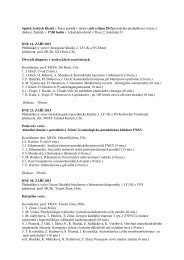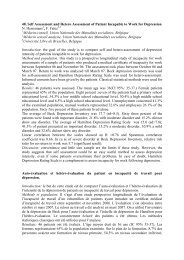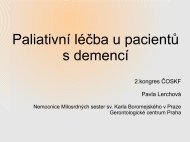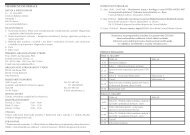ABSTRACTS â ORAL PRESENTATIONS - AMCA, spol. s r.o.
ABSTRACTS â ORAL PRESENTATIONS - AMCA, spol. s r.o.
ABSTRACTS â ORAL PRESENTATIONS - AMCA, spol. s r.o.
You also want an ePaper? Increase the reach of your titles
YUMPU automatically turns print PDFs into web optimized ePapers that Google loves.
P72. IMPACT OF HISTONE DEACETYLASE INHIBITORS ON ANTICANCER EFFECTS OF<br />
CYTOSTATICS<br />
Tomáš Groh 1 , Helena Maříková 2 , Jan Hraběta 2 , Ashraf M. Khalil 2 , Tomáš Eckschlager 2 ,<br />
Marie Stiborová 1<br />
1<br />
Department of Biochemistry, Faculty of Science, Charles University, Prague<br />
2<br />
Department of Pediatric Hematology and Oncology, 2 nd Medical School, Charles<br />
University, Prague<br />
grohtomasmail@gmail.com<br />
During the last few decades, several approaches have been applied in effort to discover<br />
more effective anticancer drugs. Many promising compounds have been investigated.<br />
However, chemoresistance is one of the main causes of failure of treatment. Epigenetic<br />
changes are the changes of gene expression or cellular phenotype caused by mechanisms<br />
other than are the changes in DNA sequence. Histone acetylation has been investigated<br />
as therapeutic target because of its importance in regulation of gene expression.<br />
Different histone deacetylase (HDAC) inhibitors induce death of cancer cells by different<br />
mechanisms that include changes in gene expressions and alterations of both histone<br />
and non-histone proteins. Enhanced histone acetylation in tumors results in modification<br />
of expression of genes involved in cell signaling. Inhibition of HDACs causes changed<br />
expression of 2-10 % of genes involved in important biological processes. Inhibition<br />
of HDACs leads to changes in chromatin architecture that can result in modulation of<br />
gene transcription. Inhibitors of HDACs have also an impact on non-histone proteins.<br />
They can change their stability and interaction with other proteins or with DNA. The<br />
results of experiments and clinical studies have demonstrated that combination of<br />
HDAC inhibitors with some anticancer drugs have synergistic or additive effects. Valproic<br />
acid (VPA) is known as an anticonvulsant used for a treatment of bipolar disorder and<br />
epilepsy. Last decades, VPA is also studied as an inhibitor of histone deacetylases. Beside<br />
VPA, trichostatin A (TSA) is another compound utilized as an HDAC inhibitor.<br />
We tested the effect of non-toxic concentrations of VPA and TSA on cytotoxicity of<br />
different cytostatics to human neuroblastoma cells. VPA increases cytotoxicity of<br />
etoposide, cisplatin but not vincristine in co-cultivation experiments. Similar, but lower<br />
effects exhibited TSA. Valpromide, an analogue of VPA that lack the histone deacetylase<br />
inhibition effect, did not increase cytotoxicity of etoposide and cisplatin. Inhibition of<br />
histone deacetylases by VPA seems to influence cell proapoptotic signals or regulate<br />
reparation machineries of neuroblastoma cells. We have found that VPA increased<br />
cytotoxicity of etoposide to neuroblastoma cells in vitro, if etoposide was co-cultivated<br />
with VPA, but preincubation of these cells with VPA did not increase the etoposide<br />
efficacy. We observed the same trend using cisplatin. The results provide additional<br />
evidence for the use of VPA in complex anticancer therapy.<br />
Acknowledgements<br />
This work was supported by GAUK635712, UNCE204025/2012 and P301/10/0356.<br />
Analytical Cytometry VII 175








